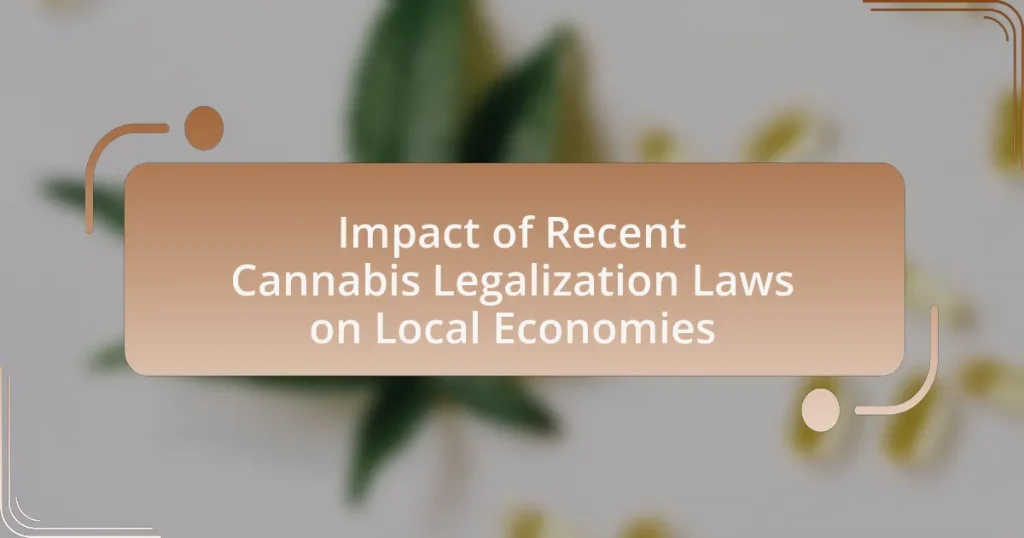The article examines the impact of recent cannabis legalization laws on local economies, highlighting their objectives to regulate cannabis production, distribution, and consumption while promoting public health and safety. It discusses the variations in legalization laws across different regions, influenced by cultural, political, and economic factors, and their effects on tax revenues, job creation, and local business growth. Additionally, the article addresses the intended economic benefits of legalization, the challenges faced by local governments, and the long-term implications for public health and safety, ultimately emphasizing the need for effective regulation and equitable economic growth strategies.

What are the Recent Cannabis Legalization Laws and Their Objectives?
Recent cannabis legalization laws aim to regulate the production, distribution, and consumption of cannabis while promoting public health and safety. For instance, in 2021, New York legalized recreational cannabis, intending to generate tax revenue, reduce criminal justice costs, and address social equity by expunging past cannabis-related convictions. Similarly, New Jersey’s legalization in the same year focused on creating a regulated market to enhance economic growth and ensure public safety. These laws reflect a broader trend across various states to capitalize on the economic benefits of cannabis while addressing historical injustices related to its prohibition.
How do these laws vary across different regions?
Cannabis legalization laws vary significantly across different regions, influenced by local political, cultural, and economic factors. For instance, in the United States, states like California and Colorado have implemented comprehensive legalization frameworks that allow for both medical and recreational use, resulting in substantial tax revenue and job creation. In contrast, states such as Texas maintain strict prohibitions, limiting cannabis use primarily to low-THC medical products, which restricts economic benefits. Internationally, Canada has fully legalized cannabis, leading to a regulated market that has generated billions in economic activity, while countries like Japan enforce stringent anti-cannabis laws, resulting in minimal economic impact from the cannabis sector. These regional differences illustrate how local governance shapes the economic implications of cannabis legalization.
What factors influence the differences in legalization laws?
Differences in legalization laws are influenced by cultural attitudes, political climate, economic considerations, and public health perspectives. Cultural attitudes shape societal acceptance of cannabis, leading to varying levels of support for legalization across regions. The political climate, including the stance of lawmakers and the influence of lobbying groups, directly affects the legislative process and outcomes. Economic considerations, such as potential tax revenue and job creation, motivate some jurisdictions to adopt more lenient laws. Public health perspectives, including concerns about safety and addiction, also play a crucial role in shaping legalization policies. For instance, states like Colorado and California have embraced legalization due to strong public support and perceived economic benefits, while others remain restrictive due to differing cultural and political contexts.
How do these variations impact local economies?
Variations in cannabis legalization laws significantly impact local economies by influencing tax revenues, job creation, and local business growth. For instance, states that have legalized cannabis for recreational use, such as Colorado, reported over $1.7 billion in tax revenue from cannabis sales in 2020, which has been reinvested into public services like education and infrastructure. Additionally, the cannabis industry has created thousands of jobs; Colorado alone saw an increase of over 30,000 jobs in the sector since legalization. These economic benefits demonstrate that variations in legalization laws can lead to substantial financial gains and employment opportunities within local communities.
What are the intended economic benefits of cannabis legalization?
The intended economic benefits of cannabis legalization include increased tax revenue, job creation, and reduced law enforcement costs. Legalizing cannabis allows governments to impose taxes on its sale, generating significant revenue; for example, Colorado collected over $1.5 billion in cannabis tax revenue from 2014 to 2021. Additionally, the cannabis industry creates jobs in cultivation, distribution, and retail, contributing to local employment; the Bureau of Labor Statistics reported that the cannabis sector employed over 300,000 workers in the U.S. by 2021. Furthermore, legalization reduces the financial burden on law enforcement and the judicial system associated with prosecuting cannabis-related offenses, allowing resources to be redirected to other public safety initiatives.
How do legalization laws aim to create jobs?
Legalization laws aim to create jobs by establishing a regulated market for cannabis, which necessitates a workforce for cultivation, distribution, retail, and ancillary services. These laws lead to the creation of direct employment opportunities in cannabis-related businesses, such as dispensaries and farms, while also generating indirect jobs in sectors like security, transportation, and marketing. For instance, a report from the Leafly Jobs Report in 2021 indicated that the legal cannabis industry supported over 320,000 jobs in the United States, demonstrating the significant employment impact of legalization.
What revenue generation opportunities do these laws present?
Recent cannabis legalization laws present significant revenue generation opportunities through taxation, licensing fees, and job creation. These laws enable local governments to impose taxes on cannabis sales, which can lead to substantial revenue; for instance, Colorado generated over $1.5 billion in cannabis tax revenue since legalization in 2014. Additionally, licensing fees for cannabis businesses contribute to local budgets, with states like California collecting millions annually from these fees. Furthermore, the establishment of a legal cannabis market creates jobs in cultivation, distribution, and retail, stimulating local economies and increasing consumer spending.

What are the Immediate Economic Impacts of Cannabis Legalization?
The immediate economic impacts of cannabis legalization include increased tax revenue, job creation, and stimulation of local businesses. For instance, states like Colorado reported over $1.5 billion in cannabis sales in 2020, generating approximately $387 million in tax revenue, which is allocated to education and public health programs. Additionally, the legalization of cannabis has led to the creation of thousands of jobs in cultivation, distribution, and retail sectors, contributing to lower unemployment rates in those areas. Furthermore, local businesses, such as restaurants and hotels, often see increased patronage from cannabis tourism, further enhancing the local economy.
How does cannabis legalization affect local employment rates?
Cannabis legalization generally increases local employment rates. This occurs as new businesses emerge in the cannabis industry, creating jobs in cultivation, distribution, retail, and ancillary services. For instance, a report from the Leafly Jobs Report indicated that the legal cannabis industry supported over 300,000 jobs in the United States as of 2021, with significant growth projected in states that have legalized cannabis. Additionally, research from the University of California, Berkeley, found that cannabis legalization led to a 20% increase in employment in the retail sector in California. These statistics demonstrate that cannabis legalization positively impacts local employment by generating new job opportunities and stimulating economic growth.
What types of jobs are created in the cannabis industry?
The cannabis industry creates a variety of jobs, including cultivation workers, dispensary staff, extraction technicians, compliance officers, and marketing professionals. Cultivation workers are responsible for planting, growing, and harvesting cannabis plants, while dispensary staff assist customers and manage sales. Extraction technicians focus on processing cannabis into oils and edibles, ensuring product quality and safety. Compliance officers ensure that businesses adhere to state regulations, which is crucial in a heavily regulated industry. Marketing professionals develop strategies to promote cannabis products and brands. According to a report by Leafly, the cannabis industry employed over 428,000 people in the United States as of 2020, highlighting its significant impact on job creation in local economies.
How do these jobs compare to those in other sectors?
Jobs in the cannabis sector typically offer higher wages and more rapid growth compared to many traditional sectors. For instance, the cannabis industry has seen job growth rates exceeding 27% annually, significantly outpacing the national average job growth rate of around 1.5% in other sectors. Additionally, positions in cannabis cultivation and retail often provide salaries that are 10-20% higher than similar roles in agriculture and retail, respectively. This wage premium is supported by the increasing demand for cannabis products and the need for skilled labor in a rapidly evolving market.
What is the effect on local tax revenues?
The effect on local tax revenues from recent cannabis legalization laws is generally positive, as these laws often lead to increased tax income for municipalities. For example, states like Colorado and California have reported significant revenue boosts; Colorado generated over $387 million in tax revenue from cannabis sales in 2020 alone. This increase in local tax revenues can be attributed to the establishment of sales taxes on cannabis products, licensing fees for dispensaries, and additional taxes on cultivation. Such financial gains can be reinvested into community services, infrastructure, and public health initiatives, further enhancing local economies.
How are tax revenues from cannabis sales utilized in local communities?
Tax revenues from cannabis sales are utilized in local communities primarily to fund public services and infrastructure projects. For instance, many jurisdictions allocate a portion of these revenues to education, public safety, and health services. In Colorado, for example, the state reported that over $1 billion in cannabis tax revenue has been directed towards public schools, mental health programs, and substance abuse treatment initiatives since legalization in 2014. This allocation demonstrates a direct impact on community welfare and development, reinforcing the positive economic effects of cannabis legalization on local economies.
What challenges do local governments face in managing these revenues?
Local governments face several challenges in managing revenues from cannabis legalization, primarily due to regulatory complexities, fluctuating market dynamics, and public health concerns. Regulatory complexities arise from the need to navigate a patchwork of state and federal laws, which can lead to confusion and inconsistent enforcement. Fluctuating market dynamics, including price volatility and competition from the black market, can impact revenue stability. Additionally, public health concerns related to cannabis use necessitate funding for education and health programs, which can strain budgets. These challenges are compounded by the need for effective tax collection mechanisms and the potential for increased administrative costs associated with compliance and oversight.

What are the Long-Term Economic Effects of Cannabis Legalization?
The long-term economic effects of cannabis legalization include increased tax revenue, job creation, and reduced law enforcement costs. For instance, states like Colorado have generated over $1.5 billion in tax revenue since legalization in 2014, which has been allocated to education and public health programs. Additionally, the cannabis industry has created tens of thousands of jobs, contributing to lower unemployment rates. Furthermore, legalization reduces the financial burden on law enforcement and the judicial system, as resources are redirected from prosecuting cannabis-related offenses to addressing more serious crimes. These factors collectively enhance local economies and promote sustainable growth.
How does cannabis legalization influence local business growth?
Cannabis legalization significantly influences local business growth by creating new market opportunities and increasing tax revenues. Legalized cannabis markets generate jobs in cultivation, distribution, and retail, contributing to local employment rates. For instance, a report from the Colorado Department of Revenue indicated that the state generated over $1.5 billion in cannabis sales in 2020, leading to substantial tax revenue that supports public services. Additionally, ancillary businesses, such as security, marketing, and packaging, also thrive in legalized environments, further stimulating local economies.
What types of businesses benefit from cannabis legalization?
Cannabis legalization benefits several types of businesses, including dispensaries, cultivation facilities, and ancillary service providers. Dispensaries directly sell cannabis products to consumers, generating significant revenue; for example, in states like Colorado, dispensaries reported over $2 billion in sales in 2020. Cultivation facilities grow cannabis plants, contributing to the supply chain and creating jobs; the cannabis industry in California alone supports over 100,000 jobs. Ancillary service providers, such as packaging companies, marketing firms, and legal services, also thrive as they support the cannabis sector’s operational needs. These businesses collectively enhance local economies through job creation, tax revenue, and increased consumer spending.
How does the cannabis market affect competition among local businesses?
The cannabis market increases competition among local businesses by introducing new players and diversifying product offerings. As cannabis becomes legalized, existing businesses, such as retail shops and restaurants, must adapt to the presence of cannabis dispensaries and related services, which can attract customers and alter spending patterns. For instance, a study by the National Bureau of Economic Research found that cannabis legalization led to a 15% increase in the number of new businesses in local economies, indicating heightened competition. Additionally, local businesses may need to innovate or enhance their marketing strategies to retain customers who might be drawn to cannabis-related establishments, further intensifying competitive dynamics.
What are the social and economic challenges associated with cannabis legalization?
Cannabis legalization presents several social and economic challenges, including regulatory complexities, public health concerns, and market volatility. Regulatory complexities arise as governments must create frameworks that balance public safety with business interests, often leading to inconsistent laws across jurisdictions. Public health concerns include increased substance use, particularly among youth, and potential strains on healthcare systems due to cannabis-related health issues. Market volatility can result from fluctuating demand and competition, impacting local economies reliant on cannabis revenue. For instance, a study by the National Bureau of Economic Research found that states with legalized cannabis experienced both increased tax revenue and challenges related to enforcement and public health, highlighting the dual nature of economic impacts.
How do legalization laws impact public health and safety?
Legalization laws significantly impact public health and safety by regulating the production, distribution, and consumption of cannabis, which can lead to both positive and negative outcomes. For instance, studies have shown that states with legalized cannabis experience a reduction in opioid-related deaths, as individuals may substitute cannabis for prescription painkillers. A 2019 study published in the American Journal of Public Health found that states with medical cannabis laws had a 25% lower rate of opioid overdose deaths compared to states without such laws. Conversely, legalization can also lead to increased cannabis use among adolescents, raising concerns about mental health issues and impaired driving. Research from the National Institute on Drug Abuse indicates that cannabis use among high school seniors increased from 2017 to 2020 in states that legalized recreational use. Thus, while legalization can enhance public health by reducing opioid dependency, it also poses challenges that require ongoing monitoring and regulation to ensure safety.
What are the potential downsides for local economies?
The potential downsides for local economies due to recent cannabis legalization laws include increased crime rates, strain on public resources, and potential negative impacts on local businesses. Increased crime rates can occur as illegal markets may still thrive alongside legal ones, leading to competition and violence. A study by the National Institute on Drug Abuse found that areas with legalized cannabis often experience a rise in property crimes. Additionally, local governments may face increased costs in law enforcement and public health services, diverting funds from other essential services. Furthermore, established businesses may suffer as cannabis dispensaries can attract customers away from traditional retail, leading to reduced sales for local shops.
What best practices can local governments adopt to maximize economic benefits?
Local governments can maximize economic benefits from cannabis legalization by implementing comprehensive regulatory frameworks that ensure safety, promote business growth, and generate tax revenue. Establishing clear licensing processes for cannabis businesses encourages compliance and fosters a competitive market, which can lead to job creation and increased local investment. For instance, states like Colorado have seen over $1 billion in tax revenue since legalization, demonstrating the financial potential of well-regulated cannabis markets. Additionally, local governments should engage in community outreach to educate residents about the benefits and regulations of cannabis, which can enhance public support and participation in the local economy.
How can local governments effectively regulate the cannabis industry?
Local governments can effectively regulate the cannabis industry by implementing comprehensive zoning laws, establishing licensing requirements, and enforcing strict compliance measures. Zoning laws allow municipalities to designate specific areas for cannabis cultivation, distribution, and retail, thereby controlling the location and density of cannabis businesses. Licensing requirements ensure that only qualified operators can enter the market, which can include background checks and financial disclosures. Additionally, enforcing compliance measures, such as regular inspections and penalties for violations, helps maintain industry standards and public safety. Evidence from states like Colorado, which has seen significant tax revenue and job creation since legalization, supports the effectiveness of these regulatory frameworks in managing the cannabis industry while benefiting local economies.
What strategies can be implemented to ensure equitable economic growth?
To ensure equitable economic growth, strategies such as inclusive policy-making, targeted investment in underserved communities, and equitable access to resources must be implemented. Inclusive policy-making involves engaging diverse stakeholders in the decision-making process, ensuring that the voices of marginalized groups are heard and considered. Targeted investment focuses on directing funds and resources to areas that have historically been neglected, thereby fostering development where it is most needed. Equitable access to resources, including capital, education, and technology, enables all individuals and businesses to participate in and benefit from economic opportunities. Research indicates that regions with inclusive economic policies experience higher growth rates and reduced income inequality, demonstrating the effectiveness of these strategies in promoting equitable economic growth.


